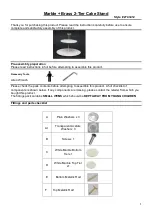
32 - USE
91477A188/A
Rosé wines
Generally, the rules for serving rosé wines are
the same as for whites. However, it is important
to consider these wines' tannin content and
serve them at a higher temperature if necessary
so that their flavour is not too sharp. Tannin
content permitting, young, fresh rosé wines are
served between 10°C and 12°C, while more
robust, full-bodied types, including more mature
wines, can be served between 12°C and
14°C.
Red wines
The serving temperature for red wines depends
on a great deal of factors, but in view of their
higher tannin and lower acidity than whites, they
are usually served at higher temperatures.
Young red wines with low tannin are usually
served between 14° and 16°C, while for more
full-bodied types 16°C or in exceptional cases
even 18°C may be recommended.
Young red wines high in tannins and with a fairly
uncomplicated structure can be served at
between 12°C and 14°C without tasting too
sharp, and will still be very pleasant. This rule
applies to “nouveau” wines, made by a special
method which reduces their tannin content; they
can be appreciated to the full at cooler
temperatures than other red wines.
Sparkling wines
In view of the large number of types of sparkling
wines on the market, there would be little sense
in laying down one rule to fit them all. Sweet,
aromatic white sparkling wines can be served at
a temperature as low as 8°C. Their aromatic
nature means they are excellent at low
temperatures.
Sweet red sparkling wines such as Brachetto
may be served at temperatures between 10°C
and 12°C. Here again, the more aromatic
sparkling wines are suitable for lower
temperatures, even down to 8°C, while those
with a slightly higher tannin content require
temperatures as high as 14°C.
Dry sparkling wines made by the “Charmat
method” or “Martinotti method”, such as some
Prosecco wines, can be served at temperatures
between 8°C and 10°C.
Sparkling wines made by the “traditional
method” and the “méthode Champenoise”,
such as Champagne, require special
consideration: in general these sparkling wines
are served at temperatures between 8°C and
10°C. However, for prestige wines marked with
the vintage, or sparkling wines that have been
aged for a long time, even 12°C may be
advisable to allow the development of the
complex bouquet that has been slowly and
painstakingly built up over the years.
Dessert wines and fortified wines
These two types of wine generally both contain
a high alcohol percentage and they are both
often also sweet. However, there are dry
dessert wines, such as Marsala, with a sugar
content so low as to be almost imperceptible on
the palate. For these wines, the serving
temperature depends on which features you
wish to emphasise. If you prefer to accentuate
the wine's sweetness, the complexity of its
bouquet and its austerity, it should be served at
a high temperature, between 14°C and 18°C.
Remember that in this case its alcohol content
will also be more in evidence.
If you require a fresher sensation, or to reduce
the sweetness of over-sweet wines, serve at a
lower temperature, between 10°C and 14°C.
Young, fresh, dry dessert wines can be served at
colder temperatures, below 10°C. This makes
the alcohol content considerably less
noticeable. However, remember that as the
temperature is reduced the bouquet also
becomes less evident. One of these wines' key
characteristics is the charm and complexity of
their bouquet; serving them too cold also means
sacrificing this important feature.
Storage temperatures
To enjoy the flavour and bouquet of each wine
at its best, it should be stored and drunk at a
specific temperature. The recommended
temperatures for different kinds of wines are
given below.
Type of wine
Temp. (°C)
Young whites
10 - 12
Mature whites
12 - 14
Young, light rosés
10 - 12
Mature, full-bodied rosés
12 - 14
Nouveau reds
10 - 14
Young, light reds with low tannin
14 - 16
Mature, full-bodied reds with high
tannin
16 - 18
Very mature and cask-aged reds
16 - 18



































